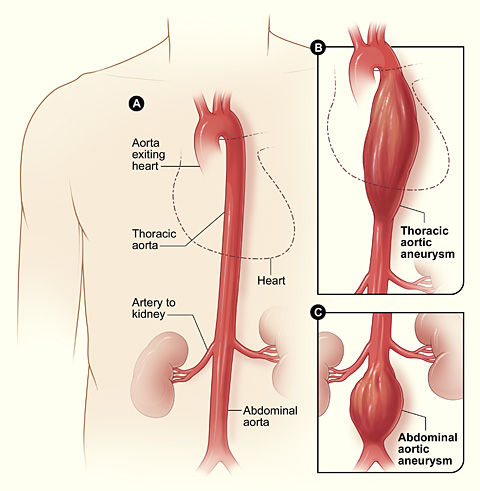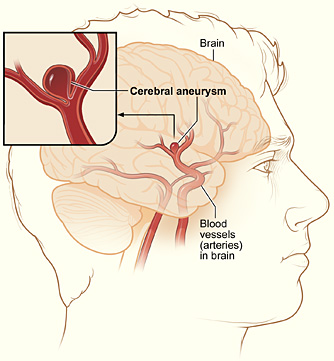Types of Aneurysm
Types of aneurysm include aortic aneurysms, cerebral
aneurysms, and peripheral aneurysms.
Aortic Aneurysm
Most aneurysms occur in the aorta. The aorta is the
main artery that carries blood from the heart to the rest of the body. The
aorta comes out from the left ventricle of the heart and travels through the
chest and abdomen. The two types of aortic aneurysm are thoracic aortic
aneurysm (TAA) and abdominal aortic aneurysm (AAA).
Thoracic Aortic Aneurysm
An aortic aneurysm that occurs in the part of the
aorta running through the thorax (chest) is a thoracic aortic aneurysm. One in
four aortic aneurysms is a TAA.
Most TAAs do not produce symptoms, even when they
are large. Only half of all people with TAAs notice any symptoms. TAAs are
identified more often now than in the past because of chest
computed tomography (CT) scans performed for other medical
problems.
In a common type of TAA, the walls of the aorta
become weak and a section nearest to the heart enlarges. Then the valve between
the heart and the aorta cannot close properly and blood leaks backward into the
heart. Less commonly, a TAA can develop in the upper back away from the heart.
A TAA in this location can result from and injury to the chest such as from an
auto crash.
Abdominal Aortic Aneurysm
An aortic aneurysm that occurs in the part of the
aorta running through the abdomen is an abdominal aortic aneurysm. Three in
four aortic aneurysms are AAAs.
An AAA can grow very large without producing
symptoms. About 1 in 5 AAAs rupture.

Figure A shows a normal aorta.
Figure B shows a thoracic aortic aneurysm located behind the heart. Figure C
shows an abdominal aortic aneurysm located below the arteries that supply the
kidneys.
Cerebral Aneurysm
Aneurysms that occur in an artery in the brain are
called cerebral aneurysms. They are sometimes called berry aneurysms because
they are often the size of a small berry. Most cerebral aneurysms produce no
symptoms until they become large, begin to leak blood, or rupture.

The illustration shows a typical
location of a cerebral (berry) aneurysm in the arteries supplying blood to the
brain. The inset image shows a closeup of the sac-like aneurysm.
A ruptured cerebral aneurysm causes a
stroke. Signs and symptoms can include a sudden, extremely
severe headache, nausea, vomiting, stiff neck, sudden weakness in an area of
the body, sudden difficulty speaking, and even loss of consciousness, coma, or
death. The danger of a cerebral aneurysm depends on its size and location in
the brain, whether it leaks or ruptures, and the person’s age and overall
health.
Peripheral Aneurysm
Aneurysms that occur in arteries other than the
aorta (and not in the brain) are called peripheral aneurysms. Common locations
for peripheral aneurysms include the artery that runs down the back of the
thigh behind the knee (popliteal artery), the main artery in the groin (femoral
artery), and the main artery in the neck (carotid artery).
Peripheral aneurysms are not as likely to rupture as
aortic aneurysms, but blood clots can form in peripheral aneurysms. If a blood
clot breaks away from the aneurysm, it can block blood flow through the artery.
If a peripheral aneurysm is large, it can press on a nearby nerve or vein and
cause pain, numbness, or swelling.
|

